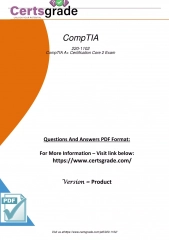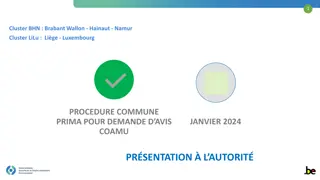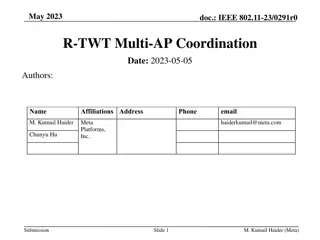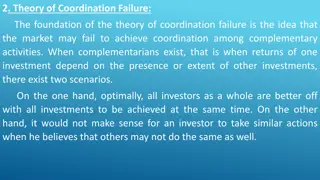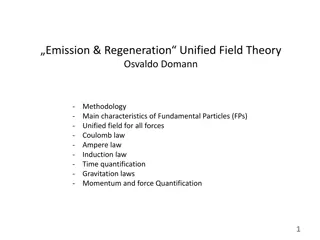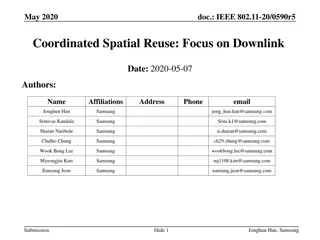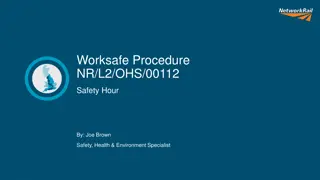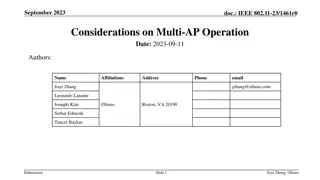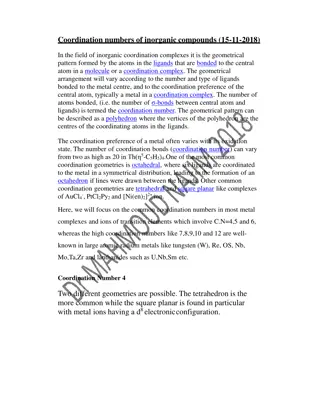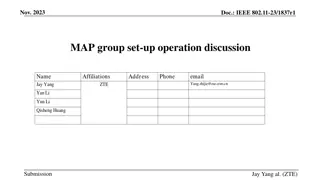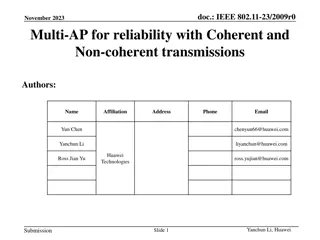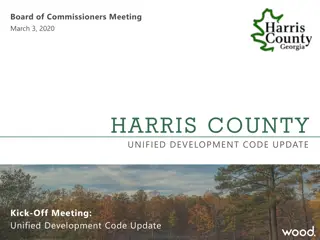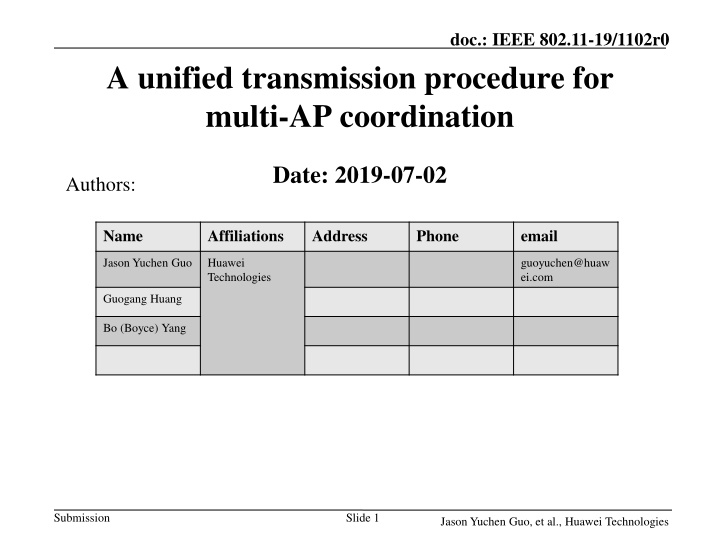
Unified Transmission Procedure for Multi-AP Coordination in IEEE 802.11-19
Explore the unified transmission procedure proposed for multi-Access Point (AP) coordination in the IEEE 802.11-19 standard. The procedure addresses synchronization, resource allocation, and modes like Coordinated BF, Coordinated OFDMA, and more to enhance performance in various scenarios.
Download Presentation

Please find below an Image/Link to download the presentation.
The content on the website is provided AS IS for your information and personal use only. It may not be sold, licensed, or shared on other websites without obtaining consent from the author. If you encounter any issues during the download, it is possible that the publisher has removed the file from their server.
You are allowed to download the files provided on this website for personal or commercial use, subject to the condition that they are used lawfully. All files are the property of their respective owners.
The content on the website is provided AS IS for your information and personal use only. It may not be sold, licensed, or shared on other websites without obtaining consent from the author.
E N D
Presentation Transcript
doc.: IEEE 802.11-19/1102r0 A unified transmission procedure for multi-AP coordination Date: 2019-07-02 Authors: Name Affiliations Address Phone email Jason Yuchen Guo Huawei Technologies guoyuchen@huaw ei.com Guogang Huang Bo (Boyce) Yang Submission Slide 1 Jason Yuchen Guo, et al., Huawei Technologies
doc.: IEEE 802.11-19/1102r0 Introduction In the PAR of EHT SG, Multi-Access Point (AP) Coordination has been considered as a main candidate feature [1]. Item 5.2b: The main candidate features that have been discussed are: 320MHz bandwidth and more efficient utilization of non-contiguous spectrum, Multi-band/multi-channel aggregation and operation, 16 spatial streams and Multiple Input Multiple Output (MIMO) protocols enhancements, Multi-Access Point (AP) Coordination (e.g. coordinated and joint transmission), Enhanced link adaptation and retransmission protocol (e.g. Hybrid Automatic Repeat Request (HARQ)), If needed, adaptation to regulatory rules specific to 6 GHz spectrum There are many modes of Multi-AP Coordination, such as Coordinated BF [2][3][6] Coordinated OFDMA [3] Coordinated SR [4] Joint transmission [5] Many contributions have shown performance gain in various scenarios[2-5] In this contribution, we propose a unified transmission procedure to support the above multi-AP coordination modes Submission Slide 2 Jason Yuchen Guo, et al., Huawei Technologies
doc.: IEEE 802.11-19/1102r0 Requirements of multi-AP transmission Two key aspects that are needed in the unified procedure are synchronization and resource allocation. Synchronization In joint transmission, very tight synchronization is needed to ensure a reasonable performance [5]. In co-BF and co-OFDMA, symbol level synchronization is needed to avoid mutual interference between OBSS [6]. In co-SR, PPDU level synchronization is preferred to make the mutual interference controllable. Resource allocation In all the modes, slave APs need to know how long the transmission could be In joint transmission, slave APs need to know which data frames to send, what transmission parameters to use In co-OFDMA, slave APs need to know which channels/RUs to use In co-BF and co-SR, slave APs need to know the receiving STAs to decide the beamforming vector and transmit power Hence, a specific frame is needed to provide the synchronization and resource allocation functions. We propose to use a slave trigger frame to perform the above functions. Submission Slide 3 Jason Yuchen Guo, et al., Huawei Technologies
doc.: IEEE 802.11-19/1102r0 Unified transmission procedure The master AP shall transmit a slave Trigger frame (TF) to initiate the multi-AP transmission How to determine the master AP is TBD The master AP can be a selected AP which is pre-defined The master AP can be any AP that successfully accesses the channel The function of the slave TF includes Synchronization for all the APs Make sure the transmissions from all APs start and end at the same time Time/frequency/phase synchronization for joint transmission Symbol level synchronization for co-BF and co-OFDMA PPDU level synchronization for co-SR Resource allocation for the slave APs Notifying the slave APs which mode to use Allocating the time/frequency/spatial/power domain resources that can be used by each slave AP Submission Slide 4 Jason Yuchen Guo, et al., Huawei Technologies
doc.: IEEE 802.11-19/1102r0 Examples of frame exchange sequence DL procedure slave TF + simultaneous DL data + UL BA UL procedure slave TF + simultaneous basic TF + simultaneous UL data + DL BA AP 1 (master) AP 1 (master) Slave TF Data 1 Slave TF Basic TF BA BA Data 1 Data 2 BA AP 2 AP 2 Basic TF BA Data 2 Data 3 BA AP 3 AP 3 Basic TF BA Data 3 Submission Slide 5 Jason Yuchen Guo, et al., Huawei Technologies
doc.: IEEE 802.11-19/1102r0 Slave Trigger Frame format Regarding the slave trigger frame format, one option is to reuse the Trigger frame format defined in TGax, which contains a Common info field and one or more User Info fields The common info field carries the information for all slave APs The user info field carries the information for a specific slave AP Use a reserved value of the Trigger Type field to represent slave TF Another option is to define a new subtype of control frame Frame Control Duration RA TA Common Info Per AP Info Per AP Info Padding FCS Both options are considerable Submission Slide 6 Jason Yuchen Guo, et al., Huawei Technologies
doc.: IEEE 802.11-19/1102r0 Conclusion We propose a unified transmission procedure for multi-AP coordination which supports various types of coordination modes, including Coordinated BF Coordinated OFDMA Coordinated SR Joint Transmission Two possible options of slave trigger frame format are discussed Submission Slide 7 Jason Yuchen Guo, et al., Huawei Technologies
2018 doc.: IEEE 802.11-19/1102r0 Reference [1] 11-18-1231-06-0eht-eht-draft-proposed-par [2] 11-18-1510-01-0eht-ap-coordinated-beamforming-for- eht [3] 11-18-1509-00-0eht-features-for-multi-ap-coordination [4] 11-19-801-00-0eht-ap-coordination-in-eht [5] 11-19-0384-00-0eht-joint-processing-mu-mimo-update [6] 11-19-0638-00-00be-nulling-and-coordinated- beamforming Submission Slide 8 Jason Yuchen Guo, et al., Huawei Technologies

